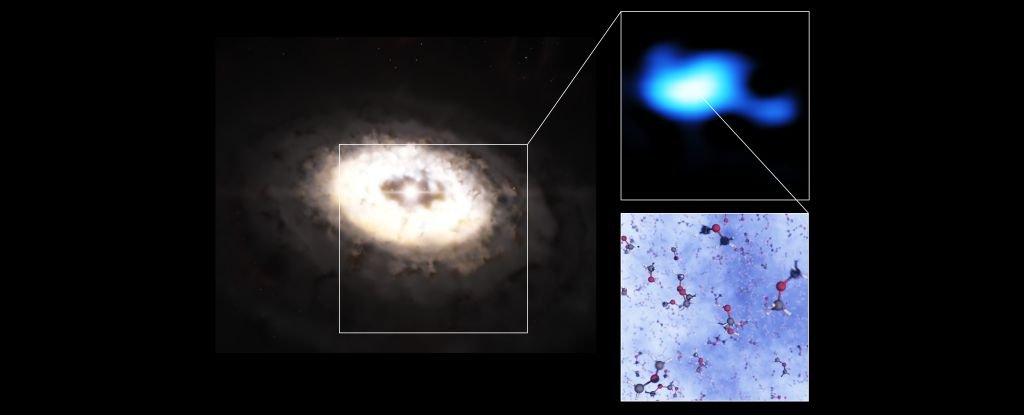Products You May Like
The largest molecule yet found in a roiling disk of dust and gas around a baby star has been identified, scientists report.
In this swirling cloud, astronomers detected the signature of dimethyl ether, a molecule that contains nine atoms. This oxygen-bearing molecule can act as a building block for sugars and other biomolecules, which means we can consider it a prebiotic compound.
Because the disk around the star, named IRS 48, will clump together to form exoplanets, the discovery of the molecule could have important implications for our understanding of how life emerges in the Universe.
“From these results, we can learn more about the origin of life on our planet and therefore get a better idea of the potential for life in other planetary systems,” says astronomer Nashanty Brunken of Leiden University in the Netherlands.
“It is very exciting to see how these findings fit into the bigger picture.”
Dimethyl ether is the simplest of the ethers, and is not uncommon in space. In fact, it’s among the most abundant molecules detected in star-forming regions in interstellar space. It consists of two carbon atoms, six hydrogen atoms, and an oxygen atom, with the chemical formula CH3OCH3.
It’s thought that these molecules form in cold star-forming regions, before the stars form from the thick clouds of dust therein. Scientists think that simple molecules, such as carbon monoxide, stick to grains of dust and form ice layers that undergo reactions to form even more complex molecules.
The detection in the disk around IRS 48, a star 444 light-years away in the constellation of Ophiuchus, occurred because of an asymmetrical crescent-shaped feature in the disk where larger dust particles concentrate, likely formed as a result of another body between the feature and the star.
This “dust trap“, as it is known, is a region where dust particles can clump together into larger and larger clumps that could eventually form comets, asteroids, and perhaps even planets.
The discovery of the dust trap was detailed in a 2013 paper. In a paper released last year, astronomers revealed that the dust trap is also rich in ices that contain complex molecules. So Brunken and her team turned the powerful Atacama Large Millimeter Submillimeter Array (ALMA) in Chile to the star to see what they could detect.
When radiation from the star reaches the dust trap, it causes ices to sublimate. If you are using a powerful enough telescope, you can detect the signature of the molecules therein based on the spectrum.
As different molecules absorb and re-emit light, they can generate dark (absorption) and bright (emission) features on the spectrum of light that reaches the telescope.
Emission features detected by ALMA were strongly consistent with dimethyl ether, the researchers say. In addition, they made a tentative detection of methyl formate, a simple ester with the formula CH3OCHO, also a building block for organic molecules.
“It is really exciting to finally detect these larger molecules in discs. For a while we thought it might not be possible to observe them,” says astronomer Alice Booth of Leiden University.
“What makes this even more exciting is that we now know these larger complex molecules are available to feed forming planets in the disk. This was not known before, as in most systems these molecules are hidden in the ice.”
The abundance of dimethyl ether in star-forming regions, coupled with this discovery, suggests that the molecule may also be abundant in protoplanetary disks. It also means that it’s possible to trace the full interstellar path of these molecules, from stellar nurseries to planets.
“We are incredibly pleased that we can now start to follow the entire journey of these complex molecules from the clouds that form stars, to planet-forming discs, and to comets,” says astronomer Nienke van der Marel of Leiden Observatory.
“Hopefully with more observations we can get a step closer to understanding the origin of prebiotic molecules in our own Solar System.”
The research has been published in Astronomy and Astrophysics.
Full credit for top image: Artist’s impression of dimethyl ether in the protoplanetary disk around IRS 48. (ESO/L. Calçada, ALMA [ESO/NAOJ/NRAO]/A. Pohl, van der Marel et al., Brunken et al.)
